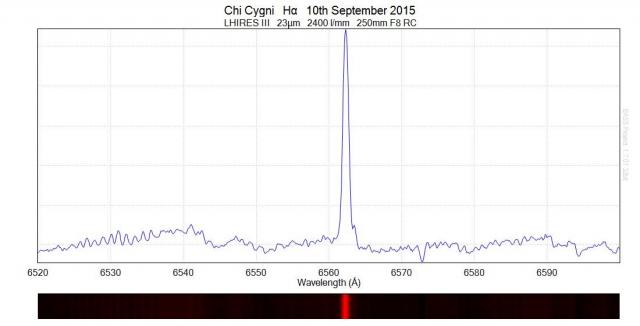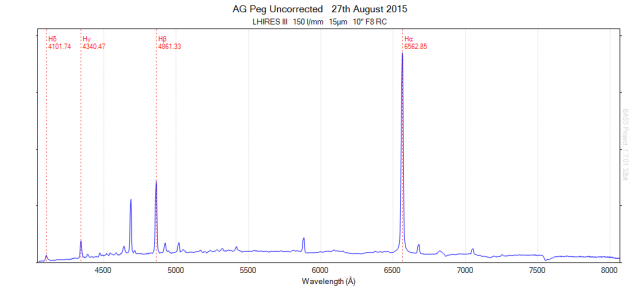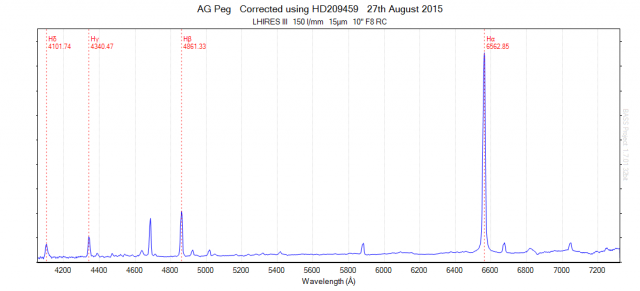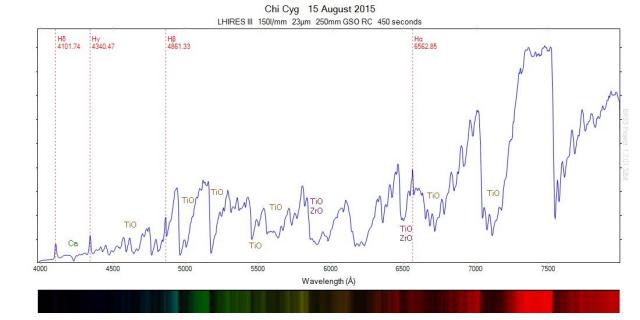Forum Replies Created
-
AuthorPosts
-
16 September 2015 at 8:30 pm in reply to: Wolf Rayets and Symbiotics spectra – a busy night! #577042
 Andy WilsonKeymaster
Andy WilsonKeymasterHi Steve,
Great, the continuum did look as though it had been corrected. As I understand it to get best quality results using a reference star at similar altitude to the target is the important thing, within reason. I think I’m getting better at these corrections, but I still need more practice. I have been experimenting by taking spectra of 2 standard stars and comparing the correction curves.
Really nice results you got that night. It is fantastic when everything comes together.
Cheers,
Andy
15 September 2015 at 9:30 pm in reply to: Wolf Rayets and Symbiotics spectra – a busy night! #577037 Andy WilsonKeymaster
Andy WilsonKeymasterThose a great spectra Steve. That really was a busy night for you with lots of different stars. The biggest obvious change I can see in chi Cyg is the H-Beta line has dropped in strength.
They look as though they might have instrument and atmospheric correction? Is that right?
Cheers,
Andy
 Andy WilsonKeymaster
Andy WilsonKeymasterHere is a high resolution spectrum that I took of chi Cygni on 10th September, “zooming” in on the hydrogen alpha emission line. The spectrum shows wonderful complexity at this level of detail, though I can’t say that I’m able to interpret most of it. I suspect a lot is due to molecular absorption bands.

I have tried to identify the absorption line at about 6572 Angstroms but to no avail. Neutral Yttrium and singly ionised calcium have lines in that region, but they may not be the cause of this absorption line.
Best wishes,
Andy
 Andy WilsonKeymaster
Andy WilsonKeymasterHi Cam,
That is a fabulous image. You’ve got the structure in the nebula really coming out well along with some background nebulosity. What exposure was the image, and was this taken with your Williams Optics 81mm?
Best wishes,
Andy
 Andy WilsonKeymaster
Andy WilsonKeymasterThanks Robin. Those are really useful links and information on response correction. I’m starting to get a handle on it but still plenty to learn!
Andy
 Andy WilsonKeymaster
Andy WilsonKeymasterHi John,
Interesting to read your posts on David’s career. That is an impressive list of telescopes which he worked on, they must have contributed a wealth of data and discoveries.
Best wishes,
Andy
 Andy WilsonKeymaster
Andy WilsonKeymasterI forgot to mention that there is no need to match the spectral class of the reference star with the target star. The reason for choosing A stars, or if not a B star as a reference, is the spectra are very simple. So it is easy to smooth the response curve after dividing the spectra to get a curve that will act as a good response.
A good way to test a response curve is to take spectra of 2 A or B stars in the Miles database at similar airmass (altitude), using one to create the response curve, and then correct the other and compare it with the Miles database. A good fit means you are doing it right, though I still usually find they are not quite the same. Low resolution can be tricky.
I also think using the same reference stars is an excellent idea. It does need to be very close to the target so that its altitude stays similar as the 2 stars track across the sky.
Best wishes,
Andy
 Andy WilsonKeymaster
Andy WilsonKeymasterHi Steve and John,
That is a great spectrum John. These are exciting times as spectroscopy is becoming more easily available to amateurs, and there are plenty of fascinating targets.
My understanding of response correction is that to get a really good atmospheric correction you need to find an A or B star of similar airmass (altitude) to your target star, and with a professional spectrum available. There are ways to get a good compromise, but for the very best results this is the way to go.
There are a couple of very handy resources that make this much easier. First there is the Miles database of standard spectra. Second a spreadsheet that allows you to locate stars from the Miles database of similar airmass to your target at the time of observation. The ARAS forum post on this subject can be found here:
http://www.spectro-aras.com/forum/viewtopic.php?f=8&t=941
Best wishes,
Andy
 Andy WilsonKeymaster
Andy WilsonKeymasterHi Steve,
Purely by coincidence I observed AG Peg the night after you. I include my uncorrected spectrum, along with a spectrum corrected for atmospheric and instrument response using HD209459. I’m not sure the correction is perfect, but I was having some computer issues that mucked up my guiding.


Best wishes,
Andy
 Andy WilsonKeymaster
Andy WilsonKeymasterHi Steve,
Nice spectrum!
Interesting to see how Chi Cyg looked in July. It is a difficult to be sure with our different setups, but I wonder if there is a hint of the hydrogen emission lines weakening from July to August. Though this is obvious when comparing the spectra on the screen, I wonder if this might be an effect of different resolutions. We’d probably need to get an accurate measure of equivalent widths to be sure.
I’m looking forward to the October meeting.
Best wishes,
Andy
 Andy WilsonKeymaster
Andy WilsonKeymasterHi Bill,
Yes, it is wonderful that Christian makes his software available for free. Spectroscopy is particularly well catered for in having a number of free good software packages out there. I’m also just learning to use PHD2 for guiding. Another free software package, really easy to use and even allows you to place a rectangle on the screen for spectroscopy so you know where the slit is.
I hope you enjoy the International Meteor Conference.
Andy
 Andy WilsonKeymaster
Andy WilsonKeymasterHi Bill,
I might give meteor spectroscopy a go sometime, but probably not just yet. I’m in the final stages of getting a new telescope and observatory setup for spectroscopy, so that is taking up all my astronomy time at the moment. I’m guessing you use a grating in front of the camera lens? Apologies if you posted above in the thread. I’d be interested to see a picture of your meteor setup.
I’ve been using a mix of BASS and ISIS. I’m gradually moving more to ISIS now as it is highly automated but a steeper learning curve.
If I’m trying to get an accurate corrected spectrum then I’ll crop off the areas I can’t properly correct. However, if I’m just looking and measuring the lines which are in the spectrum then I’ll usually keep the whole spectrum.
Cheers,
Andy
 Andy WilsonKeymaster
Andy WilsonKeymasterHi Paul,
Thanks for the advice. Your setup sounds not too disimilar to mine so it is good to hear that a powered USB hub and active cables worked for you.
I got things working with a powered hub for an observing run last weekend, and I am now waiting for another clear night to see if this really has fixed the problem. I’ve found everything just works fine in the daytime, it is only when I start proper night time observing that I get drop outs! From the sound of it powered USB cables will be the way to go if I still have problems.
Thanks,
Andy
 Andy WilsonKeymaster
Andy WilsonKeymasterHi Bill,
Reading your post I notice that you say:
“when you divide a meteor spectrum through by a stellar spectrum”
I’m not sure if this is what you really meant, as this is not how corrections are applied.
When creating a response correction you divide a stellar spectrum by a professional corrected spectrum for the same star, or at least by a standard spectrum for the spectral class of the star. This gives you your instrument and atmospheric correction. This is an imperfect process since the resolutions will be different resulting different line widths, the alignment may not be perfect, and you have atmospheric telluric lines in your spectrum. However, a smooth curve can usually be obtained by tweaking parameters and applying some smoothing to get rid of sharp bumps due to anomalies near absorption lines.
This is then your response correction. Robin’s links show this process with illustrations of actual spectra. You can the apply this response correction curve to a meteor spectrum.
The problem is this is best done with the star at the same altitude as the target. Otherwise the effect of increasing airmass has a big impact on the spectrum with decreasing altitude and the response correction will be wrong. So ideally you’d have an image with the same setup, but perhaps a longer exposure, that would include an A type star at the same altitude as the meteor. Of course the meteor is not at a single altitude so even this is not straight forward. A star at around the mid-altitude of the meteor might suffice as an approximation.
I also find it difficult to get a good correction at the extreme blue or red. When producing a corrected spectrum I just accept that I may have to crop off the extreme wavelengths.
Apologies if this is just going over what you already know.
Best wishes,
Andy
 Andy WilsonKeymaster
Andy WilsonKeymasterJohn,
That is a really nice spectrum you have captured with the SA200. The 2 spectra match really well and I’m particularly interested to see you have the 4 first hydrogen Balmer emission lines. I’d be interested to see if this changes over the coming days and weeks.
I intend to switch to high resolution mode with my LHIRES III soon, so I may not be monitoring it at low resolution.
Best wishes,
Andy
 Andy WilsonKeymaster
Andy WilsonKeymasterHere is a low resolution spectrum I took of Chi Cygni last night, 15th August 2015.
I used Richard Walker’s spectroscopic atlas to identify the Titanium Oxide and Zirconium Oxide absorption bands, though TiO is most definitely dominant. I also picked out what I believe to be the first 4 emission lines in the hydrogen Balmer series. I understand the hydrogen emission lines are caused by a radiative and hypersonic shock wave propagating through the stellar atmosphere (http://arxiv.org/pdf/1109.6500v1.pdf). I was a little hesitant in the identification of H-alpha as I have not seen it in other online spectra, but I think this is correct.

Best wishes,
Andy
 Andy WilsonKeymaster
Andy WilsonKeymasterHi Bill,
That makes sense, in as much as something odd at the blue end in the reference spectra gives you trouble correcting the continuum. Do you know what the rough continuum shape should be for meteors? Any speculation on my part would more than likely be wrong.
I’m not sure if this will help, but sometimes I use BASS to process my spectra. This creates the response correction in a slightly different way. You still use your spectrum and a reference spectrum, but once you’ve done the division you use your mouse to select specific points on the divided spectrum. BASS then joins the dots to create a smooth response curve. I’m not sure if that would give you a way to create a response curve avoiding the dips or peaks.
Instrument and atmospheric correction is a tricky area. I’ve been struggling with it myself for the better part of this year, but I think I’m about there with my latest spectra.
Fascinating work you are doing. Like you say you can get lots of useful information even without the continuum correction.
Best wishes,
Andy
 Andy WilsonKeymaster
Andy WilsonKeymasterHi Bill,
I’m glad you had a successful night with the weather cooperating! That is a nice spectrum you have captured.
I’m not sure if there is any reason why you could not apply this to meteor spectroscopy, but when I am correcting for the instrument and atmospheric response I use an A type star. Ideally one with an easily available professionally corrected spectrum. The temperature of the star is not the important thing, it does not need to match the target. The instrument response will be calculated from my spectrum compared to the professional spectrum across all wavelengths. What matters is that A stars have very simple spectra so it is easy to smooth the response as there will just be a few blips for the hydrogen lines.
Best wishes,
Andy
 Andy WilsonKeymaster
Andy WilsonKeymasterAn interesting point Robin. I had thought that this would be better suited to a lower resolution setup than my own, and I should use my low resolution grating. However, since I know the spectral line I’m interested in, then high resolution should not be a problem and as you point out the increase in contrast will be a benefit.
Cheers,
Andy
 Andy WilsonKeymaster
Andy WilsonKeymasterHi Robin,
Thanks, that is good to know. Taking a daylight spectrum sounds like a useful and interesting test anyway. It would be handy to see how well my flat correction works across the slit. With stellar spectroscopy I always aim to put the star in about the same position on the slit, but there will be times like this when I’ll want to use more of the slit height.
Best wishes,
Andy
-
AuthorPosts
